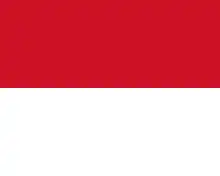Émile Roblot
Émile Henri Roblot (15 February 1886 – 24 August 1963) a French civil servant who served as the Minister of State of Monaco from 1937 to 1944.
Émile Roblot | |
|---|---|
 Roblot in 1935 | |
| 5th Minister of State of Monaco | |
| In office 10 August 1937 – 29 September 1944 | |
| Monarch | Louis II |
| Preceded by | Henry Mauran (acting) |
| Succeeded by | Pierre Blanchy |
| Personal details | |
| Born | 15 February 1886 France |
| Died | 24 August 1963 (aged 77) |
| Political party | Independent |
| Signature | .jpg.webp) |
Early life and career
Roblot was born on 15 February 1886. He studied law in Dijon where he received a doctorate in 1912 and published a doctoral thesis.[1]
He was a prefect for the French departements of and Meurthe-et-Moselle from 1931 to 1935 Bas-Rhin from 1935 to 1937.[2]
Minister of State of Monaco
Roblot was appointed Minister of State of Monaco by Louis II on 10 August 1937.[2][3]
Shortly before the start of World War II Monaco declared its neutrality. Once the war started, 800 people were mobilized in the country.[4] This and demographics of Monaco caused a great deal of tension between the Italian and French population of the country, who strongly supported different sides of the conflict.[5] Roblot had strong ties to Vichy France, and was sympathetic to the government of Philippe Pétain throughout it's existence.[6]
Throughout the World War II period, Louis II kept Roblot as his the Minister of State despite his affiliations with pro-fascist individuals, and despite demands by the Monesgasque and French populations to dismiss him.[7] When Italy occupied Monaco in 1942 and then Nazi Germany in 1943, Roblot was permitted to keep his position and played an important role in the governing of both occupations. After the Germans left Monaco in late 1944. Roblot forbid pro-Allied demonstrations. At his return to Monaco, Rainier, alarmed by the actions undertaken during and after the occupation, went to see Louis and personally asked for Roblot's dismission.[8] Louis refused but Roblot decided to resign the position in September 1944 due to popular demand by the Monesgasque population.[2][3] No charges were conducted in the country after the war.[9]
In 2010, it was revealed that Roblot had personally played a role in the rounding of 90 Jewish residents on the night of 27 August 1942 whom were handed over to Nazi Germany, all but nine were subsequently killed in the Holocaust.[10][11][12]
Honours
 Monaco: Sovereign of the Order of Saint-Charles[10]
Monaco: Sovereign of the Order of Saint-Charles[10]
.svg.png.webp) Vichy France: Medal of the Order of the Francisque[6]
Vichy France: Medal of the Order of the Francisque[6]
References
- Émile Roblot, La Séparation des Églises et de l'État et l'administration des Domaines, Séquestre des biens des anciens établissements ecclésiastiques. Thèse de Doctorat, Faculté de Droit de l'Université de Dijon, 29 juin 1912, Grenoble, Imprimerie Eymond, 1912.
- "Index Ro-Ry". www.rulers.org. Retrieved 21 March 2019.
- "Monaco". www.worldstatesmen.org. Retrieved 21 March 2019.
- Kundahl, George (2017). The Riviera at War: World War II on the Cote de Azur. I.B. Tauris & Company, Ltd. p. 293. ISBN 978-1-78453-871-2.
- "The House of Grimaldi: Louis II". Hello Monaco. 17 September 2017. Retrieved 28 May 2023.
- Coston, Henry (2002). L'Ordre de la Francisque et la révolution nationale (in French). Paris: Self-published. p. 165. ISBN 2-913044-47-6.
- Edwards, Anne (1992). The Grimaldies of Monaco: Centuries of Scandal, Years of Grace. Lyons Press. p. 668.
- Englund, Steven (1984). Grace of Monaco: An Interpretive Biography. Doubleday. ISBN 9780385188128. Retrieved 21 February 2022.
- Edwards, Anne (1992). The Grimaldies of Monaco: Centuries of Scandal, Years of Grace. Lyons Press. p. 681.
- "L'ancien ministre d'État Émile Roblot pourrait avoir été impliqué dans l'Holocauste". La Principauté ouvre le dossier Monaco Hebdo. 5 March 2010. Retrieved 16 September 2023.
- "Prince Albert apologises for Monaco's role in deporting Jews to Nazi camps". The Guardian. Associated Press. 28 August 2015. Retrieved 3 December 2021.
- Gilbert, Martin (2002). The Routledge Atlas of the Holocaust. Psychology Press. p. 10. ISBN 978-0-415-28145-4.